
|
市場調査レポート
商品コード
1636512
インドのキッチン家具:市場シェア分析、産業動向・統計、成長予測(2025~2030年)India Kitchen Furniture - Market Share Analysis, Industry Trends & Statistics, Growth Forecasts (2025 - 2030) |
||||||
カスタマイズ可能
適宜更新あり
|
|||||||
| インドのキッチン家具:市場シェア分析、産業動向・統計、成長予測(2025~2030年) |
|
出版日: 2025年01月05日
発行: Mordor Intelligence
ページ情報: 英文 120 Pages
納期: 2~3営業日
|
全表示
- 概要
- 目次
インドのキッチン家具の市場規模は2025年に13億5,000万米ドルと推定され、予測期間(2025-2030年)のCAGRは6.18%で、2030年には18億2,000万米ドルに達すると予測されます。

可処分所得の増加、都市化、核家族化がキッチン家具市場成長の重要な促進要因です。モジュラーキッチンへの関心の高まりがさらに成長を後押ししています。市場セグメントには、モジュラーキッチン、キッチンキャビネット、キッチンアイランドが含まれ、モジュラーキッチンが最も顕著で急成長しているセグメントとして浮上しています。老舗企業は需要の高まりに対応するため製造・小売能力を増強し、新興企業は技術主導のソリューションを導入しています。消費者は、モダンでカスタマイズ可能なキッチン・デザインにますます惹かれています。また、人間工学に基づいた省スペースの家具も求められています。住宅建設の急増はこの傾向を後押しし、不動産活動や、ソーシャルメディアを通じてしばしば増幅される国際的なデザイン動向の浸透も後押ししています。
市場の拡大は、より耐久性が高く、美しいキッチン家具の生産を可能にする技術や素材の進歩によっても支えられています。さらに、都市住宅プロジェクトを推進する政府の取り組みも市場の成長に寄与しています。共働き世帯の増加は、高品質で機能的なキッチンスペースの需要をさらに押し上げます。インテリジェントなキッチン家電とIoT(モノのインターネット)技術の統合も新たな動向であり、現代のキッチンの機能性と利便性を高めています。
インドのキッチン家具市場動向
インドにおける建設活動の増加が市場を活性化
近年、インドのキッチン家具市場は着実な成長を遂げています。インドの住宅建設は、人口増加、都市化、可処分所得の増加を背景に顕著に増加しています。新築住宅の増加に伴い、キャビネット、カウンタートップ、収納ソリューションなどキッチン家具の需要も並行して増加しています。同時に、インドの不動産セクターは、新しい商業施設や複合施設の建設によって拡大しています。こうした近代的な建築物には、オーダーメイドの高級キッチンが設置されることが多く、キッチン家具の需要をさらに押し上げています。インド市場では、世界の旅行やメディアから影響を受けた国際的なデザイン美学への嗜好が高まり、モジュラーキッチンへの動向が顕著になっています。その結果、インドの消費者の間では、現代的で革新的なデザイン原則を体現したキッチン家具に対する意欲が高まっています。
eコマースの台頭が市場を活気づける
eコマースの急増がインドのキッチン家具市場を後押ししています。eコマース・プラットフォームはキッチン家具へのアクセスを民主化し、主要都市やTier2、Tier3地域の消費者にリーチしています。このアクセスのしやすさは、顧客が自宅にいながらにして多様なキッチン家具を吟味し、購入できるようになったことを意味します。この動向を後押しするため、eコマース事業者はロジスティクスとサプライ・チェーンを強化し、遠隔地であっても迅速かつ効率的な配送を実現しています。さらに、多くのプラットフォームがカスタマイズ・オプションを提供し、顧客が寸法、素材、仕上げを好みに合わせてカスタマイズできるようになり、キッチン家具の魅力が高まっています。
インドのキッチン家具産業の概要
インドのキッチン家具市場は、国際的プレーヤーと国内プレーヤーが混在し、断片化と激しい競争が特徴です。このような情勢は、予測期間中に成長機会を提供するだけでなく、競合情勢を激化させています。特筆すべきは、以下のような主要市場プレイヤーです。 Sleek, Johnson Kitchens, Hafele, Haecker, and Kohler hold substantial market shares.
その他の特典:
- エクセル形式の市場予測(ME)シート
- 3ヶ月間のアナリストサポート
目次
第1章 イントロダクション
- 調査の前提条件と市場定義
- 調査範囲
第2章 調査手法
第3章 エグゼクティブサマリー
第4章 市場力学
- 市場概要
- 市場促進要因
- 都市化の進展が市場を牽引
- モジュラーキッチンの増加が市場を牽引
- 市場抑制要因
- 原材料コストの変動が市場に影響
- 市場機会
- インテリアデザイナー、建築家、ホームインプルーブメントストアとの提携が有利な機会をもたらす
- バリューチェーン/サプライチェーン分析
- ポーターズ5フォース分析
- 新規参入業者の脅威
- 買い手/消費者の交渉力
- 供給企業の交渉力
- 代替品の脅威
- 競争企業間の敵対関係の強さ
- 市場における技術革新に関する洞察
- COVID-19が業界に与える影響
第5章 市場セグメンテーション
- タイプ別
- キッチンキャビネット
- キッチンチェア
- キッチンテーブル
- その他
- 流通チャネル別
- スーパーマーケットおよびハイパーマーケット
- 専門店
- eコマース
- その他の流通チャネル
- エンドユーザー別
- 住宅
- 商業
第6章 競合情勢
- 市場集中の概要
- 企業プロファイル
- Sleek
- Johnson Kitchens
- Hafele
- Haecker
- Kohler
- Zuari Furnitures
- EBCO
- Godrej Interio
- Style Spa
- Arttdinnox
第7章 市場の将来
第8章 免責事項
The India Kitchen Furniture Market size is estimated at USD 1.35 billion in 2025, and is expected to reach USD 1.82 billion by 2030, at a CAGR of 6.18% during the forecast period (2025-2030).

Rising disposable incomes, urbanization, and a shift towards nuclear families are critical drivers of growth in the kitchen furniture market. A rising interest in modular kitchens further fuels this growth. The market segments include modular kitchens, kitchen cabinets, and kitchen islands, with modular kitchens emerging as the most prominent and fastest-growing segment. Established players ramp up their manufacturing and retail capacities to meet the escalating demand, while startups introduce tech-driven solutions. Consumers are increasingly gravitating towards modern, customizable kitchen designs. They also seek ergonomic and space-saving furniture solutions. A surge in residential construction bolsters this trend, as do real estate activities and the pervasive influence of international design trends, often amplified through social media.
The market's expansion is also supported by advancements in technology and materials, which enable the production of more durable and aesthetically pleasing kitchen furniture. Additionally, government initiatives promoting urban housing projects contribute to the market's growth. The increasing number of dual-income households further drives the demand for high-quality, functional kitchen spaces. Integrating intelligent kitchen appliances and IoT (Internet of Things) technology is another emerging trend, enhancing the functionality and convenience of modern kitchens.
India Kitchen Furniture Market Trends
Increasing Construction Activities in India is Fuelling the Market
In recent years, India's kitchen furniture market has seen steady growth, primarily propelled by a surge in the country's construction activities. India's residential construction has notably risen, fueled by population growth, urbanization, and increasing disposable incomes. With the rise in new home constructions, there's a parallel uptick in the demand for kitchen furniture, spanning cabinets, countertops, and storage solutions. Concurrently, India's real estate sector is expanding by constructing new commercial and mixed-use spaces. These modern structures often feature bespoke, high-end kitchens, further bolstering the demand for kitchen furniture. India's market is experiencing a significant trend towards modular kitchens, driven by a rising preference for international design aesthetics, often inspired by global travel and media influences. Consequently, there's a heightened appetite among Indian consumers for kitchen furniture that embodies contemporary and innovative design principles.
Rise in E-Commerce is Fuelling the Market
The surge in e-commerce is propelling India's kitchen furniture market. E-commerce platforms have democratized access to kitchen furniture, reaching consumers in major cities and Tier-2 and Tier-3 regions. This accessibility means customers can now peruse and purchase a diverse array of kitchen furniture from the convenience of their homes. To bolster this trend, e-commerce entities bolstered their logistics and supply chains, ensuring swift and efficient deliveries, even in remote areas. Moreover, many platforms now offer customization options, allowing customers to tailor dimensions, materials, and finishes to their preferences, heightening the allure of kitchen furniture.
India Kitchen Furniture Industry Overview
The kitchen furniture market in India is characterized by fragmentation and intense competition, featuring a mix of international and domestic players. This landscape not only offers growth opportunities during the forecast period but also intensifies the competitive dynamics. Notably, key market players such as Sleek, Johnson Kitchens, Hafele, Haecker, and Kohler hold substantial market shares.
Additional Benefits:
- The market estimate (ME) sheet in Excel format
- 3 months of analyst support
TABLE OF CONTENTS
1 INTRODUCTION
- 1.1 Study Assumptions and market definition
- 1.2 Scope of the Study
2 RESEARCH METHODOLOGY
3 EXECUTIVE SUMMARY
4 MARKET DYNAMICS
- 4.1 Market Overview
- 4.2 Market Drivers
- 4.2.1 Rise in Urbanization is Driving the Market
- 4.2.2 Increasing Modular Kitchens is Driving the Market
- 4.3 Market Restraints
- 4.3.1 Fluctuation in Raw Material Costs is Impacting the Market
- 4.4 Market Opportunities
- 4.4.1 Partnerships with Interior Designers, Architects, and Home Improvement Stores Present Lucrative Opportunities
- 4.5 Value Chain / Supply Chain Analysis
- 4.6 Porters 5 Force Analysis
- 4.6.1 Threat of New Entrants
- 4.6.2 Bargaining Power of Buyers/Consumers
- 4.6.3 Bargaining Power of Suppliers
- 4.6.4 Threat of Substitute Products
- 4.6.5 Intensity of Competitive Rivalry
- 4.7 Insights on Technological Innovations in the Market
- 4.8 Impact of Covid-19 on the Industry
5 MARKET SEGMENTATION
- 5.1 By Type
- 5.1.1 Kitchen Cabinets
- 5.1.2 Kitchen Chairs
- 5.1.3 Kitchen Tables
- 5.1.4 Others
- 5.2 By Distribution Channel
- 5.2.1 Supermarkets and Hypermarkets
- 5.2.2 Specialty Stores
- 5.2.3 E-Commerce
- 5.2.4 Other Distribution Channels
- 5.3 By End User
- 5.3.1 Residential
- 5.3.2 Commercial
6 COMPETITIVE LANDSCAPE
- 6.1 Market Concentration Overview
- 6.2 Company Profiles
- 6.2.1 Sleek
- 6.2.2 Johnson Kitchens
- 6.2.3 Hafele
- 6.2.4 Haecker
- 6.2.5 Kohler
- 6.2.6 Zuari Furnitures
- 6.2.7 EBCO
- 6.2.8 Godrej Interio
- 6.2.9 Style Spa
- 6.2.10 Arttdinnox*


